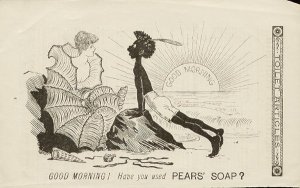Picture 1
Picture 2
Picture 3
Picture 4
Picture 5
Before I start writing, I tried many ways to research “Pears Soap” and the impact of its advertising. I was surprised at how few scholarly sources there were on the subject. Google’s top 10 search result didn’t reveal the connection between Pears Soap ad with racism or with colonialism, imperialism. I, then, tried ProQuest. Similar results. The only articles I found are summaries to a book written on Pears Soap and colonialism.
I arranged these five ads into three groups: picture 1&4, picture 2&5 and picture 3.
Picture 1&4 both imply the message that Pears Soap (imperialism) is coming from the ocean. Picture 1 gives me a feeling that the glory of British Pears Soap is going to shine upon the land of the boy. The power represented in this image is asymmetrical: the woman is the position of power as she dresses in pieces of shells, as a goddess of the ocean. She looks very friendly as she has a big smile on her face. In the background, the sun rises with “good morning” written in the middle, corresponding to what she is saying to the boy. On the other hand, the boy, whose eyes are filled with joy and excitement, is not in any place of power because his expression looks as if he is receiving a good news/product from the “modern” world. He is topless, wearing a traditional Indian feather on his head–stereotypical backward living conditions. The contrast between wealth and poverty, modern and outdated, white and black are very strong.
Different from Picture 1, In Picture 4, the illustration is more subtle in representing the superiority of the white world. Yet, the headline is quite bold: the beginning of civilization, a message from sea. The arrival of Pears Soap landmarks the civilization of that land, regardless of the decision of the locals. Along with Pears Soap, Eurocentric imperialism is coming.
The second group, Picture 2&5 both represent racism in advertising as Pears Soap is so powerful that black children can turn into white after bath. It is interesting to notice that both ads use children as the message deliveryman. Is it because children are more innocent thus trust-worthy to the audience? Both images convey the idea that dark skin color is a result of dirtiness, lack of cleaning.
Picture 3 seems to me very different from the rest of the ads. In late 19th century, Britain invaded Sudan and Picture 3 illustrates what actually happened historically in Sudan. British soldiers wrote “Pears Soap is the best” on the rock to publicize their latest advancement during the invasion. The Sudanese are portrayed as shocked as they saw the presence of divine in the ad; to the British readers, this ad became part of their historiography on Sudan.
None of those ads, at their times, caused any protests against discrimination, racism, false representation of people in other races in society. They collectively show the common mindsets of the British at that time as very closed, opinionated and Eurocentric. As Dussel says in his article, the Western tried to irrationally claim their own definition of “modernity” to universality. But how was that possible in the 19th century? Was it merely because the restrains of resources of information that the public had no access to any otherwise? Then, how are we different today? Our understanding of the non-western world is still not in proportion to the development we achieved in expanding our resources of information. Is it because that the Western still controls the economic and political power in the world so that they psychologically regard own model of modernity success?





Kuan. Strong post here. I am interested but uncertain what you are getting at in writing “Our understanding of the non-western world is still not in proportion to the development we achieved in expanding our resources of information. Is it because that the Western still controls the economic and political power in the world so that they psychologically regard own model of modernity success?” Can you try to reframe so I can respond to this part…I am interested in what you are thinking here…
I’m sorry for my wording.
What I am trying to say is: Technology advancements have tremendously enhanced our efficiency of communication, we now have more access to information, resources than ever before. However, our understanding of the non-western world has not been kept up with the speed of our technological advancement. It is like we have 21st century technology and 20th century understanding of the non-western world.
I am trying to think why it happened, and I think it is because the Western world is still on the top of the power ladder so that they view their own “modernity” a successful model, and tried to apply this model on the rest of the world. It may take the Western to not be in power in order for the Westerns to rethink about their philosophy, politics, economic decision, and many others.
I see. Yes, you would think that we the increased access we have to learn about other cutlures at our disposal, we would have increased understanding of other cultures. One issue to think about is: who is controlling what information we receive about other cultures? How many of us actually take time to consult non-mainstream sources produced by those in our own country? And how many of us actually take time to “listen,” really listen to other’s perspectives when we encounter them anyhow….???